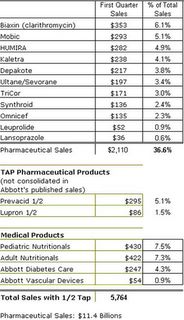Thursday, April 14, 2005
April 14, 2004 - Minyanville
Blockbuster drugs have changed the risk profile of many pharmaceutical companies. But then again not all pharmaceutical companies are created equal. The only pharmaceutical company that we hold company wide is Abbott Labs (ABT). It has all the characteristics of the major pharmaceutical company: very strong balance sheet, great cash flows, nice fat profit margins and return on capital to die for. Though Abbott has some debt, it could pay off all of its net debt (debt minus cash) from one year’s operating cash flows. In addition to all those nice qualities,
ABT has something that very few large pharmaceutical companies possess – product diversification. As very apparent from the table below, its largest drug Bioxin accounts for only 6.1% of total sales. I bet if it was recalled tomorrow it would not even make it into local news. ABT meets all of QVG criterions. All of the aforementioned qualities make it a very high quality company.
Growth ahead is likely to be consistent and predictable, with very few hiccups of small drug expirations. ABT is not facing many major drug expirations, a majority of drug expirations will happen in the second half of the next decade. Q1 2005 gave a very good indication that there is plenty of growth ahead. Though 16% sales growth was a little bit deceptive as it was helped by a weak dollar, ABT still manifested 13.4% constant dollar sales growth. The most impressive part of the report was that sales growth was company wide. There were only two weak spots in first quarter’s performance: Ross Product’s sales have only grown 1.7% in the quarter. The company’s explanation was that very strong sales in the previous quarter caused a build up in inventories at the wholesaler level. Management indicated that sales in that segment should normalize next quarter.
A note of caution, as I learned from past experience, these kinds of events should never go unchecked. If this repeats in the future, it may be an indication of channel stuffing. The second weak spot was the gross margins which declined by 2.2% to 53.1%. According to the company, gross margins were impacted by two factors: unfavorable product mix and sales of lower margin Mobic rose 185% and restructuring charges of 0.5%. I’d like to see gross margins go up, but the negative product mix argument makes sense. The lesson learned from first quarter performance, ABT is firing on all cylinders.
The company is properly positioned to benefit from baby boomers desire for a healthy life, a loathing of physical exercise and a constant pursuit to out-eat their neighbor at McDonald's (MCD).
In addition, there is an invisible warrant attached to ABT’s sales that has gotten very little attention so far. ABT has a drug eluting stent (aka DES) in the works that should make its way to the market sometime in 2007. If the drug eluting stent becomes a success it could create a nice boost for ABT’s sales.
Also, last year the FDA lifted a consent decree (a fancy word for barring products from the market) from ABT’s U.S. diagnostic business, another catalyst for higher sales growth. In fact, in Q1, the U.S. diagnostics business grew 27.2%.
My conservative expectation for long-term revenue growth is about 8-10%; margin expansion and share buy back should add another couple of percentage points bringing earnings growth to 10-12%. Add a 2.2% dividend and we are talking about nice growth with very little risk.
Value: A quick 411 on the discounted cash flow model. I use a discounted cash flow model as an indicator of direction of the value. It is not a precise tool by any stretch of the imagination. Discounted cash flow models are extremely sensitive to a multitude of assumptions, and there are plenty of those, thus expecting precise answers from the model is impractical. As Keynes said: “I would rather be vaguely right, than precisely wrong”. I am looking to be on the vaguely right side when I am using discounted cash flows.
Also, discounted cash flow models work very well in the extreme circumstances. For example, it would have kept investors away from Cisco (CSCO) and Sun Microsystems (SUNW) during the 90s bubble. Even if investors discounted their cash flows using the risk free rate (as if they had a license from U.S. government to print money, thus making basically default risk-less entities) it would show investors that expectations that were built into the bubbly stocks were not from this planet.
I find that the process of thinking through the assumptions that go into the model is as important as the final outcome. Going through the process puts me into the investor state of mind, putting things into the right perspective, forcing to evaluate my assumptions, and most importantly raises the questions that have to be answered before the stock is purchased.
My magic discounted cash flow model shows that ABT is undervalued (not advice). The expectations that are priced into the stock are for a mid single digit sales growth rate. ABT could do much better than that. Looking at historical P/E ranges, ABT is trading at one of the lowest levels ever.
ABT is unlikely to return to the glory days of the late 90s but its relatively low risk profile, predictable double digit EPS growth rate, and above average dividend lends it to an above market multiple. It is currently trading at 19x 2005 earnings and only 17x 2006 earnings. Sometime in August, Wall Street will start looking at 2006 EPS in evaluating ABT, I want to be there when they do, because the stock is very cheap on a 2006 estimates basis.
Vitaliy N. Katsenelson, CFA
Copyright Minaynville.com












0 Comments:
Post a Comment
<< Home